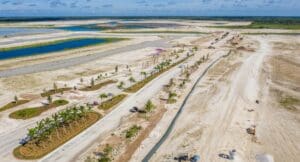
Event Recap: 2021 FES | ACEC-FL Annual Conference
Presentations, awards, networking, and more! Here’s what happened at the 2021 FES | ACEC-FL Annual Conference in Palm Beach, FL.
Learn from award-winning professionals — explore our whitepapers, blogs, and the latest industry updates.
Join our dynamic organization of engineers, land surveyors, landscape architects, environmental scientists, and architects!
Talk to a market leader today! We’ll answer any questions you have about our professional services.


Improving the building envelope can significantly impact any structure’s energy performance and thermal comfort, whether it’s a single-family home or a 100,000 SF commercial building. The envelope performance impacts the initial costs for construction materials, HVAC equipment sizing, and ongoing operating costs by reducing peak heating and cooling loads. Envelope design is typically addressed early during schematic and design developments. At that stage, since design changes are more difficult to implement once plan layouts are approved, it’s critical to be thoughtful about the envelope, for it sets in motion a cascading decision tree impacting design and ongoing costs.
Baseline energy and building codes are developed to describe required envelope assemblies for the American Society of Heating, Refrigerating, and Air-Conditioning Engineers (ASHRAE) climate zones and building structure types. But during envelope design, the same question often arises: should we go beyond prescriptive- or performance-based code insulation criteria and, if so, by how much? With that question as a cornerstone, architecture, and engineering firms Lake|Flato Architects and WGI assessed the energy impact, using respective local utility rates and then going beyond the minimum ASHRAE 90.1-2013 baseline required for wall and roof insulation in a 10,000SF wood-framed building across five climate zones: 1A in Miami, 2A in San Antonio, 3C in San Francisco, 5A in Chicago, and 7 in Duluth, Minnesota.
Two models were developed to assess energy impacts: one utilizing Autodesk Insight showing annual energy consumption, and another utilizing Trane TRACE 700 showing peak cooling/heating loads. Both modeling efforts resulted in significantly more energy-saving opportunities within improved wall envelope assemblies compared to the roof.
Enhancing wall insulation beyond the R-13 baseline for climate zones 1A, 2A, and 3C — and the R-20 baseline in climate zones 5A and 7 — has benefits for the energy use intensity (EUI), which measures energy consumption (kBtu) per square foot over a year. A lower EUI leads to annual savings through reduced electricity and natural gas usage. Going above code with additional insulation contributes to improvements in peak cooling and heating, reducing cost for HVAC equipment through smaller compressors, the downsizing of indoor and outdoor units, and smaller cabinet sizes.
While the use of insulation above the baseline helps in hot and humid areas like Miami and San Antonio, the biggest improvements are in buildings in cold climates like Chicago.
Though exceeding the baseline is beneficial in all climate zones, there is a point of diminishing returns where the expense may not be justified, and where excess insulation can lead to unfavorable wall-thicknesses and design conditions. The primary point of diminishing returns, across all the modeled climate zones, lies at adding R-7 to the cavity and continuous (cont.) R-5 to the wall. This alignment — R-20 + cont. R-5 in warmer climates, and R-27 + cont. R-5 in colder climates — compared favorably to other configurations, such as R-20 + cont. R-10, and baseline + cont. R-5.
The point of diminishing returns can be found through modeling, but human decision-making can’t be replaced. What’s easier to construct? What’s practical? Once the numbers are crunched, the informed opinion of a design team, in consultation with the client, should still be the deciding factor on what envelope configuration is used.
The case study’s basis was the Zernona S. Black Community Center in East San Antonio, an underserved area of the city. The Community Center is part of Public Architecture’s 1% program, which challenges architecture and design firms to donate at least 1% of their billable hours to pro bono work for nonprofits. The project is led by Lake|Flato with WGI providing MEP, structural, and civil engineering. The 18-month build is expected to be finished by late 2022 or early 2023.
The project consists of three buildings, a 5,500SF event center with a commercial kitchen and optional breakout rooms with foldable partitions, and two 1,500SF classrooms for child and adult learning. The buildings are stick-frame structures. The $2.2 million project is a new facility. The guiding principle is that the new facility is open, accessible, and inviting for the Center’s users, and inclusive enough to serve the east-side community. The Community Center will feature two HVAC systems, a Variable Refrigerant Flow (VRF) system coupled with a dedicated Rooftop Unit (RTU), for high-occupancy conditions for the main building, and a High Efficiency Split DX for the detached classrooms.
Even on an aggressive budget, Zernona Black will be a high-performance, custom facility with an optimized envelope that is both efficient and sustainable. The Community Center serves as a suitable representation of a typical assembly building. Results from this study can be reasonably extrapolated to inform decisions around similar-sized assembly spaces or office space. Based on the study, annual energy savings range from $111 in Miami to $745 in Duluth.
These numbers might not jump off the page, but keep in mind that in Minnesota, those savings add up to around $15,000 over the course of a 20-year cycle. As energy costs continue to rise, and as energy performance continues to be a priority for both owners and tenants, efficiency is a competitive advantage.
The reduction in initial equipment costs is typically in line with the percent reduction in peak usage. The R-20/R-27 + cont. R-5 alignment can reduce peak cooling loads by as much as 9.1%, and peak heating loads by as much as 11%, depending on the climate zone. Equipment savings range from $1,543 to over $2,000. In addition to cost — the installation expense is not affected by equipment downsizing — properly sized HVAC equipment is essential to the overall performance of a well-designed building and contributes to maintenance, durability, and longevity.
The building envelope performs many functions across all types of construction, from single family to institutional. Standing against rain, snow, wind, and sun, the envelope helps determine the building’s overall performance. Insulating it properly — by going above the code minimum — is a good way to ensure that the structure operates at the optimal level. But too much of a good thing can result in expenses that don’t offer an adequate return and can create clumsy design features. Models using the Zernona S. Black Community Center show what works for stick-frame buildings as large as 30,000SF, whether they are built in Miami, San Antonio, or Chicago.
Once the numbers are crunched, the informed opinion of a design team, in consultation with the client, should still be the deciding factor on what envelope configuration is used. Contact WGI’s experts today and let’s discuss the right envelope configuration for your next project.

WGI is a national design and professional services firm leading in technology-based solutions for the construction of public infrastructure and real estate development. At WGI, we’re providing Tomorrow’s Infrastructure Solutions Today.

Presentations, awards, networking, and more! Here’s what happened at the 2021 FES | ACEC-FL Annual Conference in Palm Beach, FL.

Exciting progress is underway at The Confluence, the next phase of Austin’s transformative Waterloo Greenway – With WGI at the forefront, key features such as stunning suspension bridges, elevated walkways, and a cutting-edge biofiltration pond are taking shape and are set to redefine connectivity and sustainability in downtown Austin as we know it.

Crucial considerations that must be taken before tackling a development project in South Florida.

In this video, we spend some time with the MEP Engineering department to learn more about their work and their team!

In this episode of WGI Unleashed, we get a chance to chat with WGI’s Mike Oler, a Market Leader in the Dallas, TX office.

By Shonda Novak – Austin American-Statesman Click Here to view the original article. A developer has released new details and images of an office tower
You’ve been searching for a place like WGI. We look forward to meeting you soon.
Sign up to receive emails to hear our latest news and achievements in our monthly newsletter.
Enter your zip code, and we’ll personalize your experience with local projects, office locations, team members, and more.
WGI supports its associates with meaningful opportunities for growth, strong benefits and perks, while we work collaboratively with clients and co-consultants to shape and improve communities.






WGI is a dynamic organization with opportunities nationwide for engineers, land surveyors, landscape architects, environmental scientists, and architects.